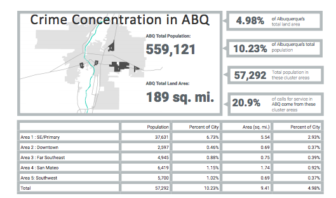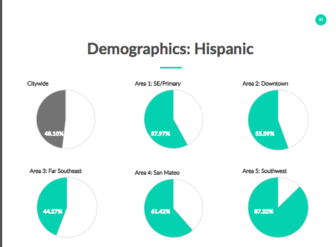
Mayor Richard Berry appears with law enforcement officials and state lawmakers in 2015 to advocate for tougher crime measures / Andy Lyman of New Mexico Political Report
The “groundbreaking research” Albuquerque Mayor Richard Berry commissioned on crime — the city’s No. 1 issue — may sit on a shelf unused when his successor takes office Dec. 1.
Why?
The two candidates headed for a mayoral runoff election next month, two-term Republican city councilor Dan Lewis and Democratic state Auditor Tim Keller, said the information about crime concentration likely won’t guide their crime-fighting plans if elected.
That’s because neither man found anything “groundbreaking” in the 134-page document Berry, a Republican, released in August through the Albuquerque Journal. It showed five “clusters” of high crime areas both candidates said have long been understood as problems for the city.
In interviews with New Mexico In Depth, both candidates — like the five others they bested in last week’s first round of voting — questioned whether the information should even be considered “research.”
Mirroring a New Mexico In Depth analysis, several candidates said the report lacked the characteristics and hallmarks of traditional, research-based studies they’d seen previously.
The report provided no clues as to where the underlying data came from, how they were crunched, or why the authors made certain decisions — such as their heavy focus on a swath of the city’s southeast quadrant, which the report heavily over-sized by square mileage and population compared to the other “clusters.”

Keller campaign Facebook page
Albuquerque mayoral candidate Tim Keller speaking at public forum organized by the Fraternal Order of Police.
“It’s shockingly lacking in insight or solutions,” Keller said. “This was truly like taking someone’s watch and telling them what time it is.”
As the clock ran out on Berry’s time in office, he used the last of a $1.2 million Bloomberg Philanthropies grant to hire a longtime Republican political operative to oversee a comprehensive study of crime, which has spiked during his eight-year administration.
The “ABQ i-Team” focused on five parts of town, including the long-maligned International District in Southeast Albuquerque, singling them out as clustered hotbeds of crime and havens for criminals.
The team’s “research” has been at the center of Berry’s eleventh-hour narrative about an issue that 99 percent of respondents to a Journal poll said was either very serious or somewhat serious.
But the candidates to replace Berry, whose approval rating is now at 34 percent and who opted not to seek a third term, said what’s been made available to the public about the i-Team’s work on crime concentration raises more questions than it answers.
NMID’s analysis, which included an interview with a national expert, found that the team’s document does not meet national standards for transparency or best practices for how to present research into complex issues such as crime in a city.
Lewis questioned the timing of the public release of the report, a first of its kind under Berry, as city voters were beginning to pay attention to the Oct. 3 election.

Image from Lewis campaign Facebook page.
Albuquerque mayoral candidate Dan Lewis speaking at public forum.
“I’m skeptical of everything, including the timing and the motives of this administration in this report, but that’s not my focus,” Lewis said, adding that he wanted to solve the problem, not criticize the outgoing administration.
Lewis added that, if elected, he would want more up-to-date information about crime in the city to aid in his decisions about how to attack it.
The i-Team’s work is laid out in a 134-page document that was first provided to the Journal in August, then posted to the team’s bare-bones website days later. It more closely resembles a PowerPoint presentation than a formal study of data and statistics.
The document is dotted with collages of photographs of high-profile local crime victims and national crime statistics cited to Fox News and Diane Dimond, a syndicated columnist whose work often appears in the Journal. There are maps, Venn diagrams, fever charts and statistical tables showing information about crime in Albuquerque from 2014 through 2016.
There is no author page, no detailed methodology, no description of how the figures cited in the document were gathered or analyzed, and no section offering conclusions or solutions. The authors also don’t explain how they chose the borders of the high-crime areas they focused on, or why breakdowns in certain crime categories are provided for some racial and ethnic groups but not others.
The document describes itself as “a presentation about ongoing research” and promises that “a formal report is expected to be issued later this year.”
With seven weeks left in Berry’s term, no full report on crime concentration has been forthcoming.
But crime has dominated the mayoral election, with each candidate calling it the city’s No. 1 issue. Given that, Lewis and Keller have criticized the lack of tools the Berry administration made available to mayoral and city council hopefuls, as well as the public, to help readers critically assess the i-Team’s document.
The “ABQ i-Team,” now in its third year of operation, was supposed to focus on “educational and employment opportunities,” according to a Berry administration news release from 2014. Much of its time appears to have been spent pondering public art projects, a KOB-TV investigation found.
But at some point, Scott Darnell took the helm of the i-Team and swung its focus to crime.

Scott Darnell
Darnell, a graduate of Harvard University’s Kennedy School of Government, appears to have little or no experience in crime statistics analysis or research. His career has included posts as chairman of the New Mexico Federation of College Republicans and as spokesman, then deputy chief of staff for Gov. Susana Martinez.
Darnell left the Martinez administration in April 2016; the governor’s former policy director, Heather McDaniel, joined him on the i-Team.
NMID emailed city spokeswoman Rhiannon Samuel on Sept. 29, four days before last week’s election, requesting interviews with Berry and Darnell about the crime concentration analysis. NMID also tried to contact Darnell through the i-Team’s website the same day.
Darnell did not respond. Samuel asked that questions be submitted to her, and she did not respond to a subsequent request for interviews on Oct. 2.
Berry and Darnell did, however, speak with the Journal last week about the i-Team’s work. The newspaper published a front page story on Sunday about the team’s “second phase” — a study of repeat offenders in the city — citing another document and quoting Darnell and Berry.
As NMID was preparing to publish this story on Wednesday, the i-Team posted the new document, “Breaking the Crime Cycle: A study on the characteristics and criminal activity of arrestees in Bernalillo County,” to its website. Unlike the crime concentrations document released in August, the newly published 79-page study included an author page, six pages describing methodology, including caveats, and lists of “next steps” and “long-term goals.”
Lack of methodology
The study posted Wednesday focused on people arrested in Bernalillo County, in particular repeat offenders. That’s different from the i-Team’s first document, which appears to focus on where crimes occur.

A summary page for the 134-page report provided by Albuquerque’s i-Team
The team’s August document purports to show that crime is heavily “clustered” in five areas of the city; so, too, are the listed addresses of people accused in those crimes. A clear narrative has emerged in news stories about the 134-page document: that a large swath of southeast Albuquerque is the city’s worst for crime.
The area, formerly known as the “War Zone,” accounted for 27 percent of the city’s murders and 20 percent of its carjackings from 2014 to 2016, according to the i-Team.
“It sticks out like a sore thumb, all the murders that are happening in the area,” Darnell told the Journal in August.
But while the total numbers of both property and violent crimes are highest in that part of the city, two other cluster areas — Downtown and along a stretch of San Mateo Boulevard — appear to have higher per capita rates of violent crime and listed addresses of accused criminals than “Southeast/Primary.”
Part of the explanation for the outsized numbers driving the narrative may be that the so-called “Southeast/Primary” area dwarfs the others examined by the i-Team in both size and population.
For example: it has 15 times more residents and eight times the square mileage of the Downtown area, and six times more people living in three times the space of the San Mateo area.
The i-Team’s report does not explain why the authors drew the boundaries of the Southeast/Primary area so much larger than the others.
There is no detailed, comprehensive methodology that would shed light on why the team made any of its interpretive decisions.
“Methods: Various approaches, more qualitative in nature — survey, focus groups, interviews, community meetings,” reads the document’s only mention of methodology.
Nancy La Vigne, director of the Justice Policy Center at the Urban Institute, described in an interview how criminal justice-related research is generally conducted. She did not review the i-Team’s report.
Providing a detailed explanation of what researchers know, what they don’t know and why they made certain decisions when working with data or information is key to building public trust, especially when presenting analyses of complicated issues such as crime, La Vigne said. It’s also a nationally accepted best practice for research.
“You need to describe the data source and how it was collected and obtained,” she said. “The methodology needs to say how the data were manipulated, whether a denominator was used and, if so, what it was. Statistical methods need to be in there, and so do the limitations of the methodology, particularly when they are big, which they often are with a crime study. Research is messy.”
At minimum, La Vigne said, researchers should make themselves available to discuss their publicly released findings.
“If you’re an academic, your whole reputation rides on your methodology,” she said. “So you have to make that transparent.”
The Berry administration has been rapped at least twice in the past year alone for pushing unexplained, incomplete or questionable research and conclusions on massive issues facing the city.
Last October, Berry hired retired University of New Mexico professor Peter Winograd to analyze the city’s crime rates. Focusing significantly on auto thefts, but other crimes as well, Winograd concluded that drastic reductions in the population at the Bernalillo County jail was the largest driver for crime in Albuquerque.
“It’s causal,” Winograd told the Journal. “It’s not just correlation.”
Correlation can mean two things are related. It’s not the same as causation, which means one thing led to another.
A month after Winograd’s analysis was released, a UNM researcher showed that finding a relationship between a reduced jail population and rising city crime rates would be difficult.
Winograd’s name appears on the “special acknowledgements” page of the i-Team’s crime concentrations report released in August.
Earlier this year, Albuquerque Business First found that the Berry administration repeatedly cited a “study” by a group of development insiders as evidence that the mayor’s controversial Albuquerque Rapid Transit (ART) project would bring $900 million and 5,000 jobs to the city. The “study,” the newspaper found, was in fact an “educated guess” from an architect who stands to make millions of dollars off the ART project.
‘Classic Berry Administration’
Beyond the lack of explanation on how the research was done, the i-Team’ made some puzzling choices for its August report on crime concentration.
One chart showing the demographic breakdown of people accused of crimes in the five “cluster areas” in the report did not mention African Americans as a group.

A slide in the August report features a series of pie charts showing the percent of crimes committed by Hispanics, but no other ethnic group.
Two pages later, another slide features a series of pie charts showing the percent of crimes committed by Hispanics in each of the five cluster areas. There are no similar pie charts for any other race or ethnicity in the report.
The document does not say why breakdowns are provided for some racial and ethnic groups but not others.
Berry is not the only political figure to use the i-Team’s report on crime concentration to sway the discussion about the city’s problems.
Congressional candidate Damon Martinez, the former U.S. Attorney for the District of New Mexico, and his successor, Acting U.S. Attorney James Tierney, have cited it as part of the reason the federal bureau of Alcohol Tobacco Firearms and Explosives (ATF) focused a massive undercover sting operation in Southeast Albuquerque last year.
The ATF operation netted a highly disproportionate number of black defendants, which has led to legal challenges based on allegations of racial profiling.
Both Martinez and Tierney, when asked about the ATF sting, have said the i-Team’s report shows that part of the city was a logical target for a law enforcement operation because of its high crime rates — even though the team’s findings weren’t released until a year after the ATF operation had concluded.
The i-Team’s “primary goal,” according to the report, “is to help the justice system efficiently and effectively stop the crime spike in Albuquerque and reduce the prevalence of crime in our community going forward.”
Berry told the Journal in August he planned to use the research as a guide for his last few months as mayor: it would help him decide where to focus crime-reduction efforts including the diminished resources of the Albuquerque Police Department, which is down about 250 officers since Berry took office in 2009.
The mayor also intended the i-Team’s report for a second purpose.
“We’re trying to put this information together … so we can hand this information off,” Berry told the newspaper. “So (the next administration) has much better information to launch from as they start making decisions on how they want to combat crime in the community.”
But none of the mayoral candidates — including Keller and Lewis — said they would use the report as-is when deciding how to address the city’s toughest issue.
Like his six opponents in the first round of voting, Lewis has said repeatedly that he plans to replace Police Chief Gorden Eden on Day 1 if he’s elected. Lewis told NMID he will direct his new chief to conduct fresh crime data analyses — based on up-to-date figures — that will help his administration choose where Albuquerque’s officers should be deployed.
Lewis and Keller agreed that, even if the i-Team’s methods were sound, its findings would be based on outdated figures by the time a new mayor walks into City Hall. That means the August report wouldn’t be worth much in the fight against crime, they said.
“To me, this is classic Berry Administration: they are using data and analysis as a proxy for action and solutions,” Keller said. “I think its purpose, at best, is to demonstrate that leadership at City Hall is trying to be thoughtful and trying to understand crime. But after eight years? This is what they should have been doing Year 1.”
The area with highest crime rate and poorest residents is in the “International War Zone” . That district was represented by Keller as Senator and currently represented by Pat flip flop Davis, City Counselor. Pat flip flop Davis has been riding Keller’s tail coat and wants to be the “go to guy” for police related matters. Keller who has no ENFORCEMENT expierance is looking to Colon, who the voters voted out? See it doesn’t make a difference?
Once again, any discussion of crime in Albuqueque, that doesn’t begin by calling out the criminals at APD, who are aided and abetted by City Hall’s cabal of attorney’s is incomplete.
Another great in-depth story. The Berry administration approach has been to generate overwhelming public opinion to support the idea that crime is THE problem. This allows them to ignore systematic solutions to the underlying causes of the crime problem – poverty, drug addiction, mental illness, … I am hopeful that will change soon with a new administration but that administration will have to overcome the misinformation that has been generated by these unscientific studies and Albuquerque Journal propaganda.